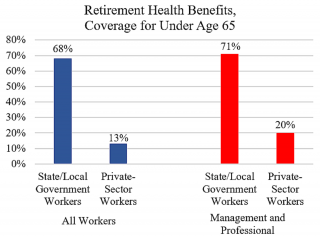We Need to Trim Government Workers' Retirement Benefits
The reforms are needed because many governments have not pre‐funded the benefits, which is an irresponsible practice.
The Wall Street Journal ran a news piece the other day on government workers entitled “Tighter Municipal Budgets Shrink Retiree Health Benefits.” The piece was sympathetic to the plight of state and local workers and opened with “America’s retired workers are getting squeezed on their health care.”
Apparently, some state and local governments are trimming retirement health benefits. The reforms are needed because many governments have not pre‐funded the benefits, which is an irresponsible practice I examined here.
What the Journal does not tell readers is that state and local government workers have some of the nation’s best retirement benefits. Most private‐sector workers do not receive any retirement health benefits, let alone the generous packages received by government workers. As taxpayers, private‐sector workers are the ones paying for generous government benefits.
Federal Medicare benefits kick in at age 65. But many government workers retire years earlier, and they continue receiving employer‐based benefits to fill the void. Journal readers may wonder why they are supposed to feel sorry for workers taking a benefit trim for a type of benefit that they may not receive at all.
The chart (above) shows data from the Bureau of Labor Statistics (pp. 339, 523). In 2020, 68 percent of state and local government workers were covered by retirement health benefits when under age 65, compared to just 13 percent of private‐sector workers. Most government jobs are “management, profession, and related,” so the chart also shows the BLS data for this category.
Many Journal news pieces imply that government spending restraint is bad. I commented on prior pieces here, here and here. I’d like to see more balance.
Note: the BLS says, “Employee benefits in state and local government should not be directly compared to private industry.” The agency cautions that the types of jobs in the public and private sectors differ. I don’t agree with the BLS’s blanket statement, but their point should be kept in mind. For this reason, I included the figures for “management, professional, and related” to show that even in similar sorts of jobs, there is a large difference in benefit coverage. The BLS data show that 11.1 million of 19.4 million state/local jobs were “management, professional, and related.”
This article first appeared on Cato at Liberty, a publication of the Cato Institute.
Image courtesy of Cato at Liberty.

